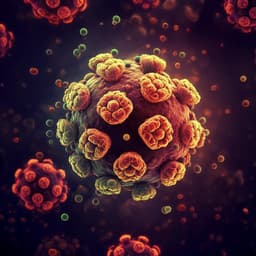
Medicine and Health
SARS-CoV-2 Omicron is an immune escape variant with an altered cell entry pathway
B. J. Willett, J. Grove, et al.
This groundbreaking research showcases how the Omicron variants BA.1 and BA.2 of SARS-CoV-2 are able to evade neutralization from vaccines, with significant implications for public health. Conducted by a team of experts, this study reveals the underlying mechanisms of these variants' pathogenicity, highlighting a crucial evolution in our fight against COVID-19.
~3 min • Beginner • English
Introduction
The study addresses how the SARS-CoV-2 Omicron variant (B.1.1.529) achieves immune evasion and increased transmission, potentially undermining spike-based COVID-19 vaccination strategies. Prior variants of concern (Alpha, Beta, Gamma, Delta) exhibited varying degrees of transmissibility and immune evasion, with Alpha and Delta spreading globally. Omicron emerged in late 2021 and rapidly split into BA.1, BA.1.1, and BA.2 sublineages, dominating worldwide. Early evidence indicated pronounced reductions in neutralization after one or two vaccine doses, with only partial restoration after three doses. The research investigates Omicron’s antigenic properties and biology, including spike mutations affecting receptor-binding domain (RBD) and N-terminal domain (NTD), potential effects on furin cleavage, and altered cell entry mechanisms, using in vitro assays and population-level vaccine effectiveness (VE) data.
Literature Review
Background work established that SARS-CoV-2 spike mutations, particularly in the RBD and polybasic cleavage site, influence antibody escape, ACE2 binding, spike processing, and cell entry (including TMPRSS2 dependence). Alpha and Delta harbored cleavage site mutations associated with increased transmissibility; Beta and Gamma were linked mainly to immune evasion. Deep mutational scanning (DMS) predicted reduced monoclonal and polyclonal antibody binding for several Omicron RBD mutations (e.g., K417N, E484A, Q493R, Q498R, N501Y). Prior reports showed decreased neutralization of variants and waning vaccine-induced immunity, with booster doses improving responses. Clinical monoclonal antibodies targeting receptor-binding motif generally showed reduced activity against Omicron, while sotrovimab, binding a conserved non-RBM epitope, retained partial activity. These studies motivated comprehensive evaluation of Omicron’s antigenicity and entry biology.
Methodology
- Study design: Combined laboratory virology, immunology, structural modeling, and population-based vaccine effectiveness analyses.
- Samples and ethics: Adult volunteers (DOVE study) provided sera and PBMCs at least 14 days after 2nd or 3rd vaccine dose (ChAdOx1, BNT162b2, mRNA-1273). Ethical approvals were obtained. Residual clinical samples for Omicron isolation were collected under biorepository approval.
- Cell lines: Calu-3 (lung), Caco-2 (intestinal), A549-ACE2-TMPRSS2 (engineered lung), HEK293/293T (production/assay), Vero, BHK-ACE2, and primary human nasal epithelial cells (hNECs). Standard culture conditions were used.
- Live virus and reverse genetics: Omicron BA.1 was isolated from patient swabs via BHK-ACE2 and Calu-3. Recombinant SARS-CoV-2 encoding Delta or Omicron spikes in a WT lineage B backbone were generated using transformation-associated recombination in yeast; rescued viruses were sequenced.
- Pseudotype neutralization assays: HIV-based pseudotypes bearing spike variants (WT/B, B.1 D614G, BA.1, BA.1.1, BA.2) were produced. Neutralizing antibody titers were measured by serial serum dilutions against 293-ACE2 target cells, calculating 50% inhibitory titers.
- Binding assays: MSD electrochemiluminescence measured IgG to SARS-CoV-2 antigens (spike, RBD, NTD, N), endemic HCoVs (229E, OC43, NL63, HKU1), and influenza antigens.
- T-cell responses: IFN-γ ELISpot on PBMCs stimulated with peptide pools from Wuhan-Hu-1 and Omicron BA.1 spike (S1/S2), reporting spot-forming cells per million.
- Entry route characterization: Pseudotype infections across cell lines favoring TMPRSS2-mediated surface fusion (Calu-3), endosomal entry (HEK), or both (A549-ACE2-TMPRSS2). Protease inhibitors Camostat (TMPRSS2) and E64d (cathepsins) were used, including titrations; live virus inhibitor sensitivity was assessed.
- Syncytia and fusion assays: Split-GFP cell–cell fusion system quantified fusion kinetics after infection with B.1, Delta, BA.1 or after spike plasmid transfection. Trypsin was used to test rescue of fusion. Immunofluorescence detected nucleocapsid to confirm infection.
- Replication kinetics: Growth curves by RT-qPCR in Calu-3 and hNECs infected with Delta or BA.1 clinical isolates.
- Domain swaps: Reciprocal swaps between WT (lineage B) and Omicron BA.1 spikes of NTD (≤319), RBD (320–576), and S2 (≥577) to map phenotypes. Pseudotype infection, inhibitor sensitivity, and spike processing (immunoblot for S1/S2) were analyzed.
- Structural/epitope analysis: Spike models (open/closed) and DMS data evaluated epitope exposure, ACE2 binding, and escape fractions.
- Vaccine effectiveness (VE): Test-negative case-control design in NHS Greater Glasgow & Clyde (1.2M adults), 6–26 Dec 2021. Logistic additive regression modeled infection with Omicron BA.1 or Delta vs negatives by vaccination status (product/doses/booster), previous infection (≥90 days), age, sex, SIMD vigintile. Immunosuppressed individuals were excluded. Omicron cases identified by SGTF, allele-specific PCR, and sequencing (Pango).
Key Findings
- Antigenic changes and ACE2 binding: Omicron (BA.1/BA.2) carries numerous RBD and NTD mutations predicted to reduce antibody binding; several mutations (e.g., G339D, N440K, S477N, T478K, Q498R, N501Y) enhance ACE2 binding.
- Neutralizing antibodies post 2 doses: Marked reduction against BA.1 compared to B.1 (D614G). Mean titers (B.1 vs BA.1): mRNA-1273 21,118 vs 285 (74-fold drop); BNT162b2 4,978 vs 148.3 (33-fold drop); ChAdOx1 882.3 vs 61.9 (14-fold drop). Absolute neutralization highest with mRNA-1273, then BNT162b2, then ChAdOx1.
- Post booster (3rd dose): Strong increases in anti-B.1 titers, especially for ChAdOx1-primed individuals (≈9.3-fold). Neutralization of Omicron variants (BA.1, BA.1.1, BA.2) improved but remained significantly lower than B.1; BA.1, BA.1.1, BA.2 neutralization did not differ significantly from each other. Detectable BA.1 neutralization observed in 62% of ChAdOx1-primed vs 25% of BNT162b2-primed boosted individuals.
- Monoclonal antibodies: Ronapreve (casirivimab+imdevimab) lost activity against BA.1/BA.1.1/BA.2; sotrovimab (Xevudy) retained activity against BA.1 and partially BA.1.1, but reduced against BA.2.
- T-cell responses: IFN-γ ELISpot responses to Wuhan-Hu-1 vs BA.1 peptide pools were similar post-boost, suggesting preserved T-cell immunity.
- Vaccine effectiveness (VE): For individuals without prior infection (≥14 days post dose): two doses vs Delta—ChAdOx1 46.3%, BNT162b2 64.0%, mRNA-1273 69.1%; against Omicron BA.1—estimates not significantly different from zero. After booster: vs Delta—BNT162b2 89.4%, mRNA-1273 90.5%; vs Omicron—BNT162b2 51.7%, mRNA-1273 45.8%. Prior infection protection: vs Delta—91.4% (unvaccinated), rising to ~99–100% with booster; vs Omicron—16.3% (unvaccinated), increasing substantially with vaccination, up to 82.5% (BNT162b2 booster) and 75.7% (mRNA-1273 booster).
- Syncytia formation: Delta > B.1 in fusion; Omicron BA.1 failed to form syncytia despite robust infection, attributable to spike changes (confirmed with reverse-genetics chimeras).
- Replication: In Calu-3 lung cells, BA.1 titers were ≥10-fold lower than B.1/Delta with delayed/less CPE; in hNECs (upper airway), BA.1 showed replicative advantage over Delta.
- Entry pathway switch: Omicron BA.1 (and BA.2) favored TMPRSS2-independent, cathepsin-dependent endosomal entry, shown by higher infection in HEK (endosomal route), sensitivity to E64d (cathepsin inhibitor), and reduced sensitivity to Camostat (TMPRSS2 inhibitor), contrasted with Delta. Spike processing (S1/S2 cleavage) was reduced for Omicron.
- Domain mapping: S2 domain determined efficient endosomal entry (route preference); RBD conferred reduced proteolytic processing and impaired syncytia formation. Trypsin treatment rescued Omicron spike fusogenicity to Delta-like levels in cell–cell fusion assays.
Discussion
Findings demonstrate that Omicron exhibits major antigenic shift with substantial escape from vaccine-elicited neutralizing antibodies, exceeding prior VOCs, while T-cell responses remain broadly preserved. Real-world data corroborate in vitro neutralization, showing reduced VE against Omicron infection after two doses and partial restoration with an mRNA booster, though protection remains lower than against Delta. The discovery that Omicron spike prefers cathepsin-dependent endosomal entry and lacks robust syncytium formation represents a fundamental biological shift relative to Delta’s TMPRSS2-dependent cell-surface fusion. This entry switch correlates with altered tissue tropism, with attenuated replication in lower-airway Calu-3 cells and an advantage in upper-airway hNECs, potentially explaining high transmissibility with comparatively altered pathogenicity. Domain swap experiments map these phenotypes to distinct spike regions (S2 for endosomal entry; RBD for cleavage/syncytia), indicating epistatic interactions and complex allostery across spike. Overall, the results explain Omicron’s rapid spread and vaccine breakthrough infections while suggesting maintained protection against severe disease due to T-cell immunity.
Conclusion
This study shows that Omicron (BA.1/BA.2) substantially evades vaccine-induced neutralizing antibodies and exhibits a switch from TMPRSS2-dependent cell-surface fusion to cathepsin-dependent endosomal entry, with impaired syncytia formation. Boosters partially restore neutralizing activity and increase VE against Omicron infection but not to levels seen against Delta. Mapping of spike phenotypes to RBD (reduced processing/fusion) and S2 (endosomal entry) clarifies mechanistic underpinnings of Omicron’s altered biology and epidemiology. Future research should: evaluate durability of booster-induced protection and protection against severe disease across age/risk groups; assess next-generation or variant-adapted vaccines; delineate how entry-route switching influences pathogenesis, tissue tropism, and transmission; and monitor emerging variants for further antigenic and functional shifts.
Limitations
- VE analyses estimated protection against detected infection in a specific region and time window; effects on severe disease were not directly assessed and are likely higher. Waning immunity and timing since vaccination influenced estimates. Immunosuppressed individuals were excluded to reduce confounding.
- Prior infection analyses include only survivors of first infection and may represent a more robust immunological cohort, potentially biasing estimates upward.
- Group-level monoclonal antibody and neutralization results are based on in vitro pseudotype/live-virus assays and may not fully capture in vivo dynamics.
- Some affiliations and broader consortium contributions complicate precise attribution; however, core experimental results were reproduced across multiple systems.
- BA.1 was the primary live-virus focus; BA.2 was tested extensively by pseudotype and select live assays, but exhaustive live-virus characterization across all sublineages was limited.
Related Publications
Explore these studies to deepen your understanding of the subject.







